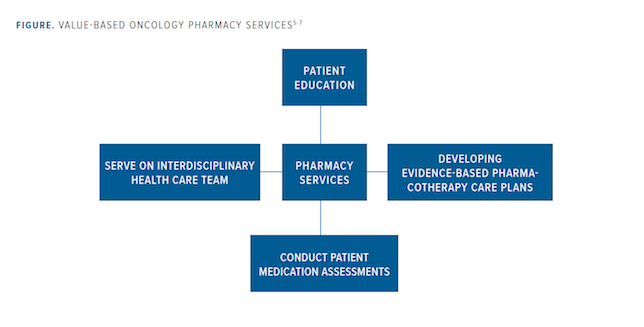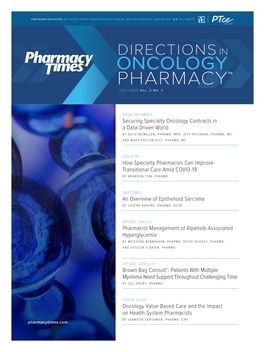Publication
Article
Pharmacy Practice in Focus: Oncology
Value-Based Oncology Care Offers Clinical Opportunities for Pharmacists
Author(s):
Pharmacists can deliver value-based oncology services as an integral part of the health care team to improve patient outcomes.
As of 2017, cancer death rates had dropped by 29% since 1991, primarily because of lower smoking rates, improvements in early detection, and treatment advances, according to the American Cancer Society.1 Cancer health care costs in 2020 are expected to reach approximately $158 billion (in 2010 dollars), which will result in a 27% increase from 2010.2
The Center for Medicare & Medicaid Innovation (CMMI) was established in 2010 to develop and test new payment models and to focus on improving the quality of specialty services for oncology care in physician practices and hospitals.3 In 2016, the CMMI established a 5-year model, known as the Oncology Care Model (OCM), to test payment methods that promote high-quality cancer care while reducing Medicare health care costs.3
Pharmacists can play an important role in value-based oncology care as part of the health care team to improve patient outcomes.
Value-Based Oncology Care and Pharmacist Implications
Pharmacists specializing in oncology care should become familiar with the various value-based models. The OCM will come to an end in 2021, and the results have been encouraging.3,4 The CMMI has proposed that its successor, known as the Oncology Care First (OCF) model, will build on the foundation of the OCM.4 The OCF will have some components similar to those in the OCM, such as a performance-based payment based on prospectively predicted total cost of care for each patient receiving active cancer treatment over a 6-month episode of care.4 Under the OCF, the potential for expanding the number and type of services bundled for patients receiving cancer treatment may arise.4
Predicting total drug costs for patients with cancer is challenging because it can be difficult to account for prices of newly approved medications.4 The OCM addressed this by including novel-therapy adjustments for new FDA drug approvals and a trend factor to account for increasing costs of oncology care at the aggregate level (all cancer types).4 However, evidence shows that cost trends can vary across different cancer types.4 The OCF has proposed to apply the novel therapy adjustment separately for each cancer type to potentially better predict total drug costs.4
In an interview, Ahzam Afzal, PharmD, founder and managing partner of chronic care management company Frontizo in Bingham Farms, Michigan, discussed the pharmacist’s role in value-based oncology care.
“Deployment of value-based medicine principles requires communication and coordination among all the parts of the health care enterprise, the use of data-driven tools to guide decision-making, and listening to the patient’s needs,” Afzal said. It’s crucial for every member of the health care team to be proactive and fully engaged.
“From a pharmacist's perspective, when looking at the planning and management of oral therapies, the integration of pharmacy into oncology practice becomes essential,” Afzal said.
Patient education is a vital component for successful health outcomes. Afzal noted that medications are constantly expanding with new drug approvals and indications, along with updated dosing and safety information gleaned from recent clinical studies.
“There are many steps that occur to make sure that patients can pay for their therapies, which may involve help from a foundation. Often, we hear that patients can afford their medications only intermittently,” Afzal said. Ultimately this leads to adherence issues resulting in adverse health outcomes. Afzal emphasized the importance of monthly follow-up calls to ensure that patients are adhering to their therapies, including discussions about lab reports and adverse drug effects.
“This 2-way communication also engages the patients and pushes them to be proactive in their own care,” Afzal said.
The CMMI recommends that a pharmacist be integrated into the health care team to coordinate and provide medication management services for intravenous and oral therapies as part of the OCM to enhance patient care (Figure).5-7 As part of a multidisciplinary health care team, pharmacists specializing in oncology can create pharmacotherapy care plans using evidence-based medicine and provide patient education regarding the drug regimen.6 Additionally, pharmacists can conduct patient assessments and adjust drug doses and regimens as part of a collaborative practice agreement. Developing protocols for oncology with medication management in care transitions can help to increase drug adherence rates.6

Evidence demonstrates that oncology pharmacists can help to meet the demands of specialty services through their clinical training.7 One study set out to project the number of board-certified oncology pharmacists (BCOPs) from 2020 to 2025 who could contribute to oncology care. The study found that approximately 2.9 million to 4.1 million 30-minute BCOP patient visits were possible at 50% workforce capacity.7 Also, the clinical activities of BCOPs overlap strongly with those of nurse practitioners and physician assistants in patient education and medication management. Therefore, BCOPs could potentially reduce provider burnout by actively participating in clinical services, using their advanced clinical training.7
Pharmacists interested in oncology should consider pursuing postgraduate year 2 oncology pharmacy residency programs and board certification as this field continues to expand.
REFERENCES
- Cancer facts & figures, 2020. American Cancer Society. Accessed June 6, 2020. https://www.cancer.org/content/dam/cancer-org/research/cancer-facts-and-statistics/annual-cancer-facts-and-figures/2020/cancer-facts-and-figures-2020.pdf.
- Mariotto AB, Yabroff R, Shao Y, et al. Projections of the cost of cancer care in the United States. J Natl Cancer Inst. 2011;103(2):117-128. doi:10.1093/jnci/djq495
- Oncology Care Model overview: Centers for Medicare & Medicaid Services Innovation Center (CMMI). CMMI. February 2020. Accessed June 6, 2020. https://innovation.cms.gov/files/slides/ocm-overview-slides.pdf
- Young G, Schleicher SM, Dickson NR, Lyss AJ. Insights from the Oncology Care First proposal—where we’ve been and where we’re going in value-based care. JCO Oncol Pract. 2020;16(4):151-153. doi:10.1200/JOP.20.00015
- Hamilton BA. Oncology Care Model: key drivers and change package. CMS. August 4, 2016. Revised June 3, 2019. Accessed June 8, 2020. https://innovation.cms.gov/files/x/ocm-keydrivers-changepkg.pdf
- Site of care pharmacy: medically integrated dispensing. Novartis. Accessed June 8, 2020. https://www.hcp.novartis.com/globalassets/care-management6/assets/mmo-1219971-site-of-care-pharmacy-tipsheet.pdf
- Knapp K, Ignoffo R. Oncology pharmacists can reduce the projected shortfall in cancer patient visits: projections for years 2020 to 2025. Pharmacy (Basel). 2020;18;8(1):43. doi:10.3390/pharmacy8010043






